Small Red Flowering Trees (With Pictures)
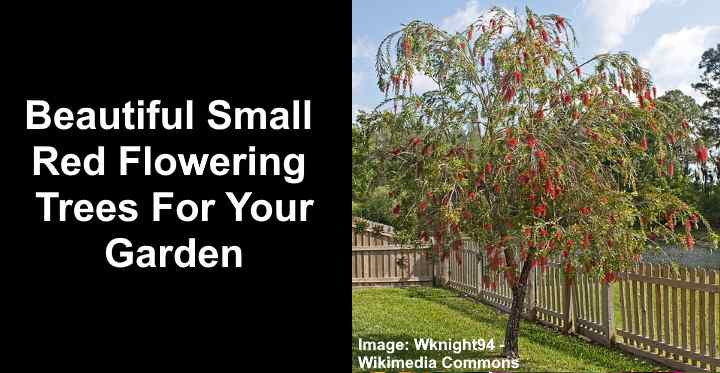
Small red flowering trees are an excellent addition to your front or backyard, especially in compact spaces where a burst of color is needed. These beautiful trees display shades of crimson, burgundy, maroon, and ruby-red, bringing a touch of natural beauty to your landscape.
When dealing with limited space, it’s a good idea to choose small red flowering trees like the red buckeye tree, red powder puff tree, or waratah tree. These trees will add a vibrant burst of color to your landscape without taking up too much space. These small red flowering trees are not only visually appealing but also easy to maintain, making them a great choice for compact gardens or yards.
This article serves as an identification guide for these stunning, small red flowering trees. You’ll find detailed descriptions and pictures of each tree species, helping you make the best selection to enhance the appeal of your small landscape.
Small Red Flowering Trees (With Pictures)
Here are some of the best small red flowering trees to plant in your garden:
Red Buckeye (Aesculus pavia)
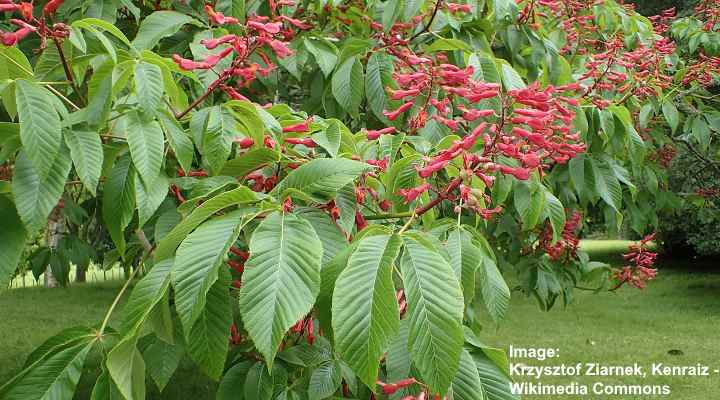
Red Buckeye is a small ornamental tree for front or backyards with reddish-pink flowers
The red buckeye is a compact flowering tree known for its beautiful reddish-pink blossoms. The red buckeye typically reaches a height of 12 to 15 feet (3.6 – 4.5 meters) and forms a rounded canopy that can spread up to 15 feet (4.5 meters) wide. During mid to late spring, this small tree showcases stunning clusters of reddish-pink flowers, providing a delightful contrast against its dark green, lance-shaped leaves.
An identifying feature of the red buckeye tree is its brown fruit or seeds, which resemble a buck’s eye. With its slow growth and small form, the red buckeye is a great tree for small landscapes. Its deep, red-colored flowers have given the red buckeye tree common names such as the firecracker plant, scarlet buckeye, and woolly buckeye.
The red buckeye tree flourishes in locations with well-drained soil and full sun. It is classified as a low-maintenance flowering tree. Red buckeye trees can be cultivated as striking specimen trees or arranged in rows to create a captivating flowering hedge. Plant this tree in USDA zones 5 to 9.
Related reading: How to identify types of buckeye trees.
Mature Size: 12 to 15 ft. (3.6 – 4.5 m) tall and wide
USDA Hardiness Zones: 5 to 9
Sun: Partial shade to full sun
Red Powder Puff Tree (Calliandra haematocephala)
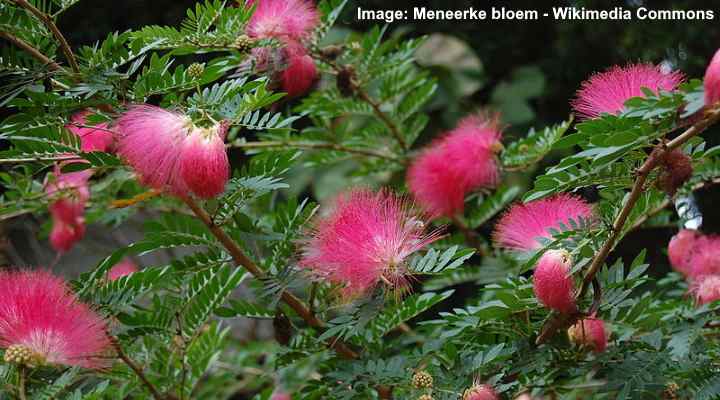
Calliandra haematocephala
The red powder puff is a large, ornamental shrub that can be shaped into a small flowering tree. Small red powder puff trees are characterized by their wide-spreading, vase-like canopy, and bright red, white, or pink flowers. The flowers of this tree resemble fan-shaped brushes dipped in vibrant red paint.
Red powder puff trees perform best in well-draining soil and are well-adapted to USDA hardiness zones 9 to 11. In addition, they also have a fast growth rate and can reach a mature height of 10 to 15 ft. (3 – 4.5 m).
Red powder puff trees thrive in sunny gardens when grown as lawn trees, corner-of-house accents, along driveways, or as patio shade trees.
Mature Size: 10 – 15 ft. (3 – 4.5 m)
USDA Hardiness Zones: 9 – 11
Sun: Full sun
Scarlet Wisteria (Sesbania punicea)

The crimson wisteria is a charming dwarf tree recognized for its clusters of vivid orange to red blossoms, resembling the pendulous wisteria blooms. These fragrant flowers bloom from late spring to early summer, attracting hummingbirds and butterflies.
The scarlet wisteria has compound leaves with small grayish-green or green leaflets. Its growth habit is bushy and multi-stemmed, with a tendency to spread. You have the option of pruning it into a small tree or allowing it to grow naturally as a shrub.
Scarlet wisterias are versatile trees that can thrive in arid conditions and flourish in a wide range of landscapes. These small decorative trees are perfect for providing shade in backyards and gardens. The attractive red flowering trees are also capable of forming lovely informal hedges or screens.
All parts of this tree are toxic, so exercise caution.
Mature Size: 10 to 15 ft. (3 – 4.5 m) tall and wide
USDA Hardiness Zones: 8 to 11
Sun: Full sun to light shade
Red Flowering Camellia (Camellia japonica)
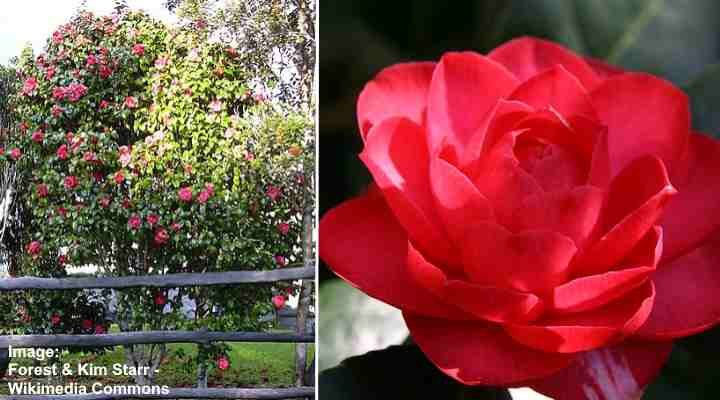
The red-flowering camellia is an evergreen tree known for its symmetrical, vibrant red flowers that resemble roses or peonies. These red flowers bloom in late winter or early spring, bringing life and color to your garden when most other plants are dormant.
Alongside its stunning red peony-like flowers, the evergreen camellia showcases shiny green leaves, contrasting nicely against the red blooms. This adaptable plant can be grown as either a tree or a shrub, offering visual appeal.
Here are some red-flowering camellia varieties that thrive under different lighting conditions, spanning from full sunlight to shade:
Camellia japonica ‘Kramer’s Supreme’: This tree has an abundance of exquisite red peony-like blooms from late winter to spring.
Camellia japonica ‘Australis’: This camellia is known for its rose-red flowers made up of curvy, ruffled petals, lasting for several months in winter.
Camellia japonica ‘Bob Hope’: This camellia variety has deep red semi-double blossoms with golden-yellow stamens, adding a burst of color to your spring landscape.
Camellia japonica ‘Lady Campbell’: This variety has glossy dark green leaves that stunningly contrast against its bright red, rose-like flowers.
Mature Size: 6 to 12 ft. (1.8 – 3.6 m) tall and 6 to 10 ft. (1.8 to 3 m) wide
USDA Hardiness Zones: 7 to 9
Sun: Partial shade to deep shade
Waratah (Telopea speciosissima)
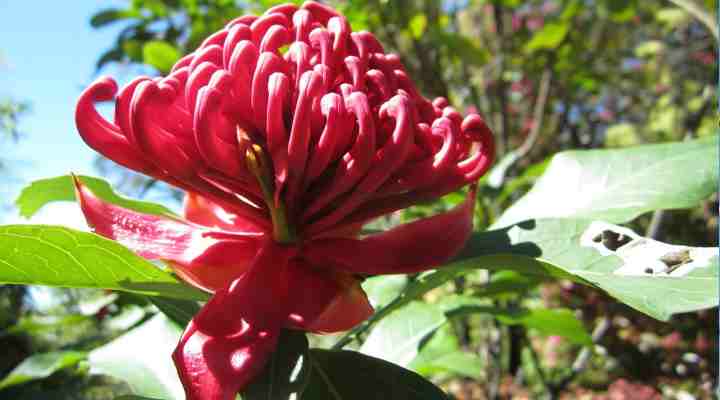
The waratah is a small tree known for its unique spherical clusters of flowers in shades of red or pink. Elongated stalks hold the flower head, which consists of multiple small flowers enclosed by vibrant bracts in red, maroon, or pink tones.
Waratah trees can also be identified by their leathery, dark-green leaves with jagged edges. These trees, known for their gradual growth and dense, compact shape, make perfect focal points in gardens or as solitary specimen trees. Their distinctively shaped flowers also make them a great option for floral arrangements.
For successful waratah growth, select a location with well-draining soil and ensure they receive full sun to partial shade. These trees are hardy and can withstand various soil conditions and the occasional drought once they are established. To ensure the best growth, protect the waratah from strong winds.
Mature Size: 3 to 10 ft. (1 – 3 m) tall and wide
USDA Hardiness Zones: 8 to 10
Sun: Full sun to partial shade
Red Flowering Grevillea Trees
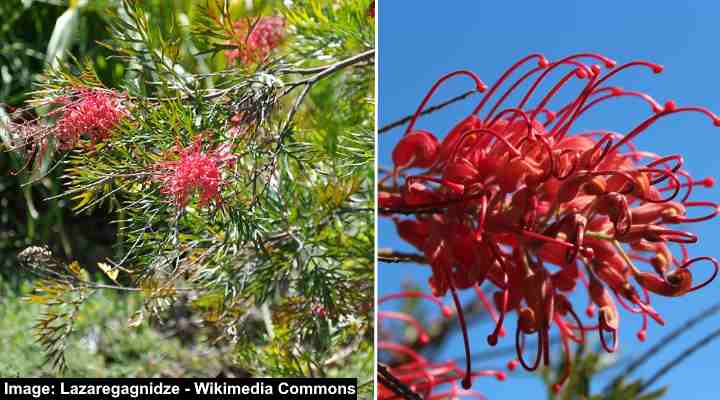
The small red-flowering grevillea tree is known for its continuous spectacle of vibrant red blooms throughout the year. This small tree produces several cylindrical clusters of red flowers. Each flower has unique, curled petals and charming arching stamens. Birds and bees are attracted to the red flowers, making them a valuable addition to any landscape or garden.
Grevillea tree leaves are slim and fern-like, commonly appearing in hues of dark green or silver-gray. Due to their drought tolerance, they are a great fit for xeriscape gardens, coastal landscapes, and dry climates. Grevillea trees are adaptable, making them suitable for hedges, screens, specimen plants, or windbreaks, presenting numerous gardening possibilities.
Mature Size: 4 to 8 ft. (1.2 – 2.4 m) tall, depending on the species
USDA Hardiness Zones: 9 to 11
Sun: Full sun to partial shade
‘Hardy Red’ Oleander (Nerium oleander ‘Hardy Red’)
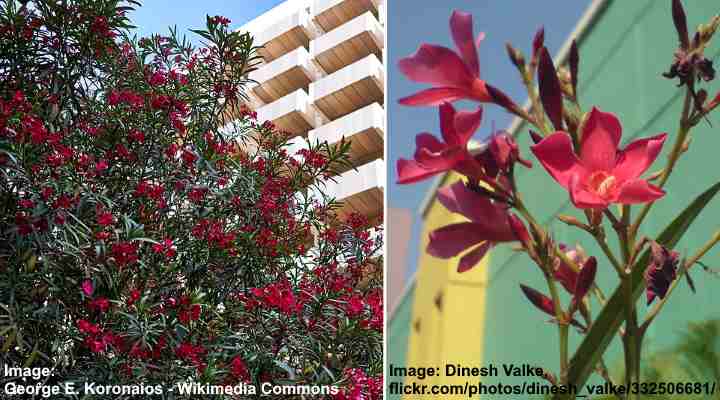
The ‘Hardy Red’ oleander is a medium-sized, evergreen shrub or dwarf tree admired for its deep red flowers. These funnel-shaped blooms add a splash of vibrant color to summer gardens. The plant displays clusters of deep red, five-petaled flowers from the beginning of spring until fall. Unlike other types of oleander, the ‘Hardy Red’ variety stands out for its resilience to cold temperatures.
Other identifying features of the ‘Hardy Red’ oleander are its vase-shaped canopy and long, dark green lanceolate leaves. You can plant this small multi-stemmed tree as an evergreen privacy screen, a red-flowering hedge, or an attractive standalone plant. The tree is low maintenance and drought-tolerant, making it a good choice for growing in hot and arid climates.
The oleander plant is poisonous, so exercise caution when planting it in areas frequently visited by children or pets.
Mature Size: 6 to 15 ft. (1.8 – 3.6 m) tall and up to 10 ft. (3 m) wide
USDA Hardiness Zones: 7 to 12
Sun: Full sun
Pomegranate Tree (Punica granatum)
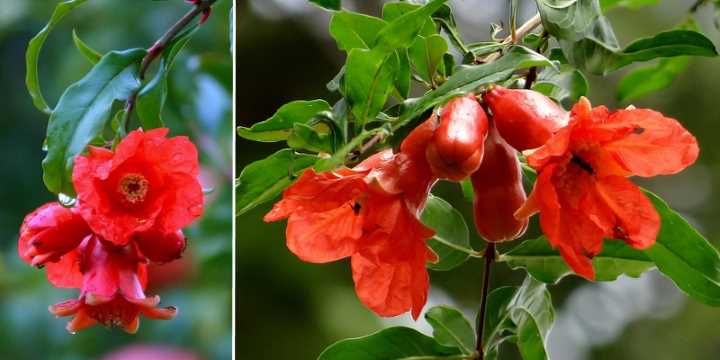
Pomegranate flowers
The pomegranate tree is a small deciduous fruit-bearing tree known for its bright red flowers and delicious fruit. This tree produces showy, tropical flowers with ruffled petals and bright yellow stamens. After the blooming of the flowers, the tree begins producing juicy, round pomegranate fruits, known for their sweet and tart taste.
The pomegranate tree is identifiable by its leathery, glossy leaves, multiple trunks, and large, pendulous fruits that stand out against the green foliage. In autumn, the leaves transform into a bright yellow color, enhancing the tree’s seasonal appeal. These trees are ideal choices for Mediterranean-style gardens and flourish when planted in containers.
Mature Size: 6 to 20 ft. (1.8 – 6 m) tall and 4 to 5 ft. (1.2 – 4.5 m) wide
USDA Hardiness Zones: 8 to 11
Sun: Full sun
Chinese Hibiscus Tree (Hibiscus rosa-sinensis)
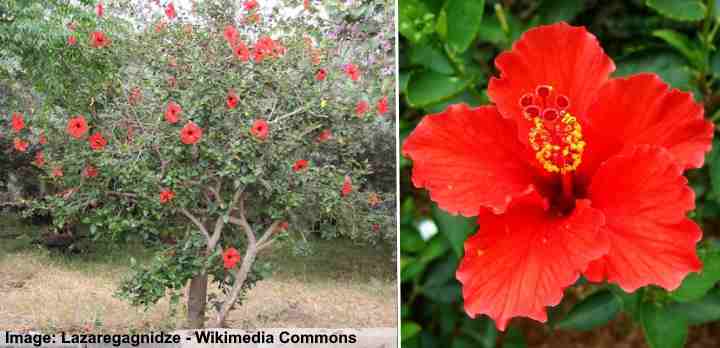
The Chinese hibiscus is a small evergreen tree that can be identified by its red trumpet-shaped flowers that emit a delightful floral scent. The flowers have dainty, paper-like petals and a protruding red or yellow stamen, producing a funnel-shaped bloom that can reach 4 inches (10 cm) in diameter.
Another identifying feature of the Chinese hibiscus is its dark green, glossy, lanceolate leaves. The tree’s flowers are often used in tropical gardens due to their ornamental appeal. Depending on the climate, this tree can be either deciduous or evergreen.
For optimal growth, plant the Chinese hibiscus in well-draining soil in full sunlight or partial shade. Make sure to water this tree in tropical regions or during dry spells. You can use the Chinese hibiscus as either a privacy hedge or screen, a standalone shrub, or an accent plant. In colder climates, they can be grown in containers or brought indoors for overwintering.
Mature Size: 8 to 16 ft. (2.5 – 4.9 m) tall and 5 to 10 ft. (1.5 – 3 m) wide
USDA Hardiness Zones: 10 to 12
Sun: Full sun to partial shade
Red Frangipani Tree (Plumeria Rubra)
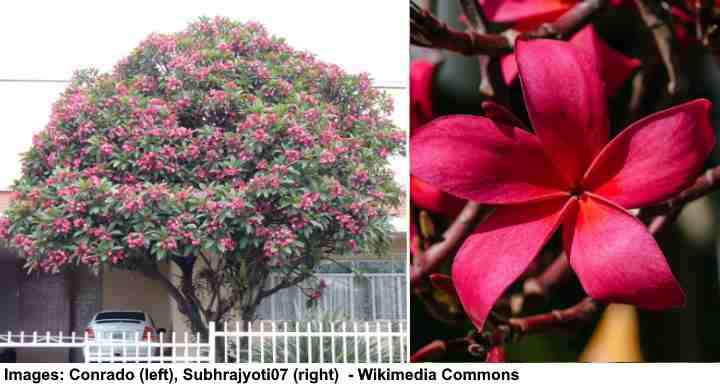
The red frangipani is a deciduous, tropical tree characterized by its red, star-shaped flowers and round or vase-shaped canopy. The tree’s flowers are a pinkish-red color and emit a delightful floral scent. It is popular in tropical gardens and landscapes for its lush foliage, exquisite flowers, and long seed pods.
The red frangipani blooms year-round, providing a constant showcase of beauty in outdoor areas. The vibrant red flowers beautifully contrast against the lush, dark green foliage. Due to its compact size, the red frangipani is a perfect fit for smaller front or backyards.
The red frangipani is native to the tropical regions of Mexico and Central America, preferring hot, humid environments. It has found popularity and extensive cultivation in various tropical regions across Asia. As a heat-tolerant species, this tree thrives in flower beds and borders, making it an ideal container or patio plant. For optimal growth, plant in soils that are moist and well-draining.
Mature Size: 15 to 25 ft. (4.5 – 7.5 m) tall and wide
USDA Hardiness Zones: 10 to 12
Sun: Full sun
Crimson Bottlebrush Tree (Melaleuca citrina)
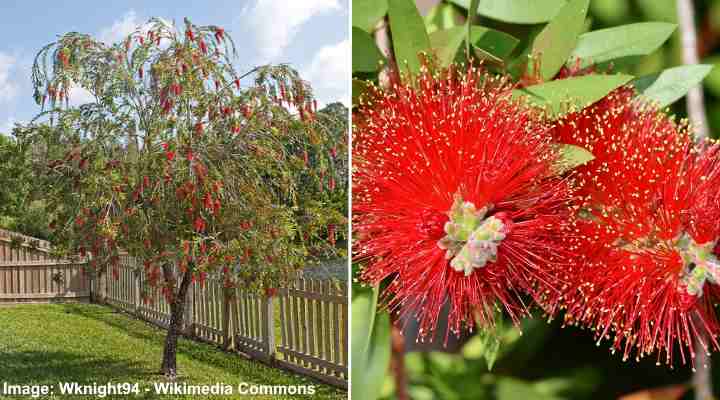
The crimson bottlebrush tree is a small, evergreen shrub-like tree known for its unique red bottlebrush-like flower spikes. These long, fuzzy, conical flower spikes have a bright red hue and release a fragrant scent, attracting pollinators such as butterflies, bees, and hummingbirds. When bruised, the leaves of this tree release a lemony aroma, giving it the alternative name of the lemon bottlebrush tree.
The crimson bottlebrush tree has slender, glossy dark green leaves that beautifully contrast against the bright red flower spikes. The leaves transition into a coppery-brown color in the fall, enhancing the beauty of the autumn landscape. Throughout the winter, the small flowering tree grows woody seed capsules that appear in clusters along the stems. The vibrant red flowers provide an attractive contrast against the green foliage.
The crimson bottlebrush tree grows best in well-drained soil and full sun. This tree is versatile and can be used as an ornamental shrub, flowering hedge, or foundational plant in landscaping. Due to its ability to withstand salty air, it is a perfect option for coastal gardens.
Mature Size: 8 to 15 ft. (2.4 – 4.5 m) tall and wide
USDA Hardiness Zones: 8 to 11
Sun: Full sun, six hours of direct sunlight or more
Related articles:
- The Most Beautiful Small Flowering Trees
- The Best Small Ornamental Trees
- Stunning Red-Flowering Trees
